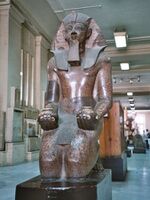Considered to be one of Egypt's greatest pharaohs, Thutmose III was the sixth ruler of the 18th Dynasty, with a reign lasting from 1479 to 1425 BC. Thutmose III took the throne after his father's death, but was not considered old enough to rule on his own. Queen Hatshepsut, his father's wife, was acting regent and spent two decades effectively ruling Egypt until her death. Once Hatshepsut died, Thutmose III was able to rule on his own.
Historians consider Thutmose III to have been the Napoleon of Egypt because of his military conquests. Nearly 350 cities were captured during his reign, all over the areas of the Near East, Nubia and Euphrates. He made seventeen military campaigns, and used warfare as a way of turning Egypt into a superpower and a military force to be reckoned with. Thutmose III is considered to be one of Egypt 's greatest warrior pharaohs.
One of the greatest accomplishments of the pharaoh was the defeat of a large group of Canaanites at the Battle of Megiddo. After the death of Hatshepsut, the Canaanites decided it was a good point to free themselves of Egyptian influence. With the help of the kings of Kadesh and Megiddo , the Canaanites revolted and Thutmose III did what he could to fight back. The main reason for keeping Egyptian control over the area was because of where Megiddo stood in terms of trade routes. Without Megiddo open to Egyptian trade, it would have been very damaging to Egyptian economy. So with an army of ten thousand men on foot and in chariots, Thutmose III quelled the rebellion and ended the siege of Megiddo after almost eight months. It was the first known battle with precisely detailed events.
Not only was Thutmose a skilled warrior, he was also a very religious man, having been educated at the Theban Temple as a young boy. He had several temples built and several others enlarged, with a multitude of statues placed in each showing him offering gifts to the gods.

When he died, Thutmose's tomb was found in the Valley of the Kings, and in the tomb was found a statement saying he reigned for just shy of 55 years. Thutmose III was buried in what is now considered tomb KV34, but he didn't not stay there. Like many other nobles, his mummy was found at the Deir el-Bahri Cache, situated above the mortuary temple of Hatshepsut. As grave robbers were fond of looting the tombs and catacombs of pharoahs and nobles alike, undaunted by the threats of curses to anyone who desecrated these sacred places, priests would often move the bodies so they would remain as undisturbed as possible.
Thutmose III's mummy had been stripped of jewels and finery before being moved by the priests to the mummy cache. The mummy itself was found in 1886, and the body was in bad shape. The face, however, had been maintained well, and gave a stark comparison to the statues found of Thutmose III's likeness. This conquering pharaoh was barely more than five feet tall, with a low forehead, deep sunken eyes, and a heavy jaw.
The remains of this great pharaoh can be found at the Cairo Museum, most likely with many artifacts from his reign as well.
Tourism, history, archeology, Karnak Temple,
Egyptian tourism, tourists historical, global tourism, Luxor Temple,
the Temple of Abu Simbel, beach tourism, Tourism Islands, Ramses II,
Nefertiti, Cleopatra, the Tower of Pisa, the Eiffel Tower, the pyramid,
the Sphinx, Tourismwinter,

No comments:
Post a Comment